Villamelendro de Valdavia
Villamelendro is a town belonging to the municipality of Villasila de Valdavia, in the region of Vega-Valdavia. It is located in the transition area between the Natural Park Montaña Palentina and the Tierra de Campos in the province Spain of Palencia (Castilla y León), on the upper side of the Triangle formed by Saldaña, Carrión de los Condes and Herrera de Pisuerga and located at the foot of the route Jacobea that linked San Vicente de la Barquera with Carrión de los Condes through the Royal way of La Valdavia.
Villamelendro de Valdavia, Spain | |
|---|---|
 | |
 Flag 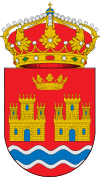 Seal | |
| Coordinates: 42°32′15″N 04°34′22″W | |
| Country | Spain |
| Autonomous community | Castile and León |
| Province | Palencia |
| Municipality | Villasila de Valdavia |
| Government | |
| • alcalde | César Sánchez Fernández (PP) |
| Area | |
| • Total | 30.25 km2 (11.68 sq mi) |
| Elevation | 880 m (2,890 ft) |
| Population (2011) | |
| • Total | 12 |
| Time zone | UTC+1 (CET) |
| • Summer (DST) | UTC+2 (CEST) |
| Website | www |
It is on the right bank of the Valdavia River, joined by the road PP-2454 called camino vecinal (0.8 km) to the kilometre 21.2 of the provincial road P236.
Physical data
Map of Villamelendro de Valdavia
- Distance to Palencia: 75.6 km
- Distance to Burgos: 88.1 km
- Distance to León: 131.3 km
- Distance to Santander: 155.6 km
Crossed by the Valdavia River from north to south, Villamelendro is on its right bank.
Demographic evolution
|
|
|
Urban development
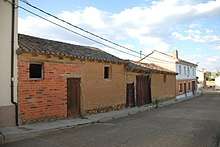
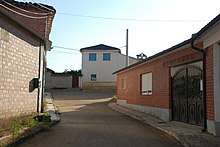
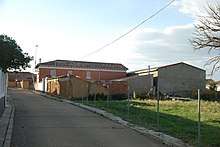
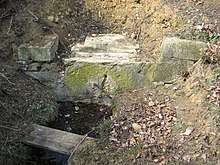
Location
The moment of the foundation of the present town centre of Villamelendro, around the 9th century, was preceded by three circumstances that determined its location: On the one hand, the northern repopulators of the late Middle Ages found the ruins of a series of buildings of Roman origin in the vicinity of the hill where the Church of Our Lady currently stands. On the other hand, crossing the arroyo de Matafrades, on the southern slope of the alto de la Horca, there was a permanent source of drinking water that guaranteed the provision of any settlement. And finally, both ruins and fountain were at the confluence of a crossroads.
From the West, coming from the Morcorio, the old road of Saldaña arrived, through Vega de Doña Olimpa. This road, crossing the river Valdavia, would project itself along the so-called road of cows in the direction of Sotobañado y Priorato and would cross with another, the royal road of Valdavia, on the northwest-southeast axis that would run through the region of Valdavia parallel to the river.
From Congosto, passing through La Puebla, Buenavista, the depopulated area of Santa María de Villaverde, Polvorosa, Renedo, Arenillas de San Pelayo, always on the left bank until it reaches Villaeles where it would cross the river and continue on its right bank along the river terraces that are not flooded, entering Villamelendro by the Villabasta road. Then it would cross the whole village until it left by the Arnillas path towards the Villanes de Villanuño and Bárcena de Campos to connect at the height of the Esperina with the camino del Besaya towards Carrión de los Condes.
It is the establishment of buildings along this road that gives an elongated shape to the town centre, articulating around the Calle Mayor, which is the name taken by the camino real de la Valdavia as it passes through Villamelendro.
Construction phases
The village has two clearly differentiated construction phases.
Depending on the position of the Church, the village fountain and the area where the Roman vicus was presumably located, we can deduce a first phase in which the oldest part of the urban centre would be the one in the far north. Specifically, the group of houses that go from the slope where the camino de Villabasta arrives to the calle Sol. This means that the intersection of the Calle Mayor with the Calle Cantarranas is the area where the original settlement of the repopulation village was structured, gradually projecting towards the river in the direction of the Calle de las Huertas which would close the complex from the east.
On the other hand, a second phase, where the rest of the houses that are to the South of the Calle Sol are being built, which although now it is in the center of the village, takes its name at a time when it was the southern end of the village, being the first street of the village to which the sun was shining at dawn. This evolution was the result of population growth and improved production conditions in the area from the sixteenth and seventeenth centuries.
Local road
The Camino Real de la Valdavia, together with the Camino Viejo de Saldaña, would be the main communication routes through which goods and travellers would arrive at the village, the Camino Real de la Valdavia being the main artery of the valley. Although there was a wooden bridge and lawns about 30 metres to the north of the current bridge, it was not until 1948 that this was built and the local road connecting to the Valdavia road was asphalted, which is the main axis of communication today.
Illustrious sons
- Lucas Espinosa (1895-1975): father Augustin and eminent Palencia philologist born in Villabasta, but that spent long seasons in Villamelendro. Specializing in indigenous languages Kokama, Kokamilla and Omagua of the Amazon, Peru.
- Matías Santos, doctor in Medicine by Universidad de Alcalá in 1678.[1]
Heritage
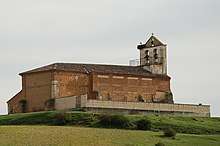
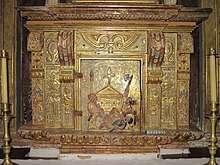
- Church of Our Lady of the Assumption: A work of brick, masonry and stonework, with a modern tower of belfry at its feet, which replaced the old tower of masonry and brick, with a hipped roof and two loopholes, which in the middle of the 20th century threatened ruin. Brick doorway of semicircular arch, preceded by a cobbled portico and an arched access doorway to sardinel, on the Epistle side. The interior consists of a single nave, separated by ashlar arches in three bodies covered with groin_vault and a high wooden choir at the feet. On the side of the presbytery is the main altarpiece from the first half of the 17th century with paintings on the bench of the Annunciation and Adoration of the Shepherds, flanked by four small panels representing the Fathers of the Church, from left to right: St Augustine of Hippo, St Gregory the Great, St Ambrose of Milan and St Jerome of Stridon on which four columns Corinthian Order are supported as an allegory for the pillars of the Church. The altarpiece is articulated around a central niche with the image of Asunción presiding and in the side streets four panels with paintings of the martyrdom of Julita y Quirico, and in the attic Crucifix. Tabernacle with relief of the Resurrection on the door. The current work dates mostly from the 16th century, and presented problems from early times. It was necessary to reinforce the building with period buttresses so that they would reinforce the pressures that the groin vaults projected outwards. In the area of the apse it is reinforced with very thick but low buttresses, as in this area the church tends to open up as well. In the cemetery area, the base of these buttresses are eroded by humidity and burials, leaving the building unprotected. That is why in the mid-20th century the arch of the presbytery was reinforced with a double tensor that gave it stability. The second arch of the nave, however, is increasingly giving way inwards, endangering the integrity of the second vault. This is the reason why this building is included in the Red List of Heritage[2]of the Association for the care and promotion of Heritage Hispania Nostra since November 2019.
History
The first written mention of this town under the name of "Uilla Melendi", along with other neighbouring villages, takes place in 1175 in a manuscript volume belongs to the monastery of Santa María de Retuerta,[3] where signs Domingo Iohannes, perhaps the parish priest of the village, as a witness to a donation of Fortun Moñoz of their inheritances in Cardeñosa, outright next to Villasila, for the benefit of the Arenillas de San Pelayo monastery, where it could have been written the same and which was subsidiary of Retuerta.
January 12, 1180, King Alfonso VIII gives jurisdiction both Villamelendro and Villasila in Carrión de los Condes, following the request made by the clergy[4] of both villages.
On 19 December 1186, just six years after the privilege granted by Alfonso VIII, the regime of both villas is changed, happening Royal to behetria as Pedro Rodríguez de Castro is contained in a diploma of Alfonso VIII signed in Arevalo, as Lord of Villasila and Villamelendro. This Castilian ricohombre was son of Rodrigo Fernández de Castro "the bald" and was married to Urraca Rodríguez de Guzmán, with whom he had no offspring.
In 1189, Pedro Rodríguez de Castro, together with his spouse, gives for their souls to the order of Santiago Villamelendro along with Villasila village. The Commander of Uclés but Franco granted to donors in prestimonio for life with the condition that after his death remain in command of the Commander of Ucles.[5]
From señorío to abadengo
After the death of the Lords, and as they left dictation in their agreement with the Uclés, Alfonso VIII runs the same being Alarcos of October 18, 1194, the final donation to the order of Santiago of the Alcazar de Alarcón, half of the portazgos of Alarcón and Alconchel, the village of Las Gascas, Villasila, Villamelendro and other inheritances.[6] This donation is reiterated a month later, on November 24 in Toledo, where Alfonso VIII gives in addition to the order, half of the portazgo Alarcón and Valera of Roa, the villas of Villasila and Villamelendro but in this case, in Exchange for the castle of Alarcon the fifth part of the income of this village and the village of Las Gascas,[7] convirtiendo ambas aldeas en villas de abadengo.
From this moment the future of both villas is marked by the activity of the hospitals of Las Tiendas and Villamartin (founded the latter for Tello Pérez de Meneses as well as of the San Nicolas del Real Camino), producing several annotations related to contributions earmarked for the maintenance of these sites,[8] or even place names of Villamelendro as "Matafrades" or ("forest of the frates or brothers)," "Las Monjas" payment in Villasila, which may allude to the santiaguistas nuns of Santa Eufemia, or the moor of stores. Even reaching the confines with Villaeles where we find the Mount of Matalabad, or our Lady matte.
The first of these annotations's news, takes place July 8, 1212, in the documentation of the monastery santiaguista female of Santa Eufemia de Cozuelos, where the sons of don Gil de Villamorco, as sellers of land located in source John Vellidez to Diaz Roiz, Commander of fields and Villasila (and therefore of Villamelendro) to the order of Santiago.[9]
In 1231, D. Alfonso Martínez and Don García Martínez, together with its wife Doña Mari Roiz and Doña Alda, founded in Villamartin Hospital an anniversary for his soul, his parents and relatives delivering its properties as compensation in Villasila, Villamelendro, Villanueva de Arriba, Villafría de la Peña, Amayuelas de Abajo and Villafolfo.[10]
March 8, 1255, King Alfonso X of Castile ratified on Aguilar de Campoo, the privilege granted 75 years before, by his great-grandfather King Alfonso VIII.[11]
October 19, 1328 Villamelendro appears again in the documentation of the said Monastery of Santa Eufemia de Cozuelos as part of a previous donation made June 15, 1327 on the part of the master of the order of Santiago Don Vasco Rodríguez de Coronado. It donates to María Gutiérrez, the Commander of Santa Eufemia,[12] charged with Villasirga, Villamartin, Villamelendro, the place of Vega Santillan and Legones (Saldaña outright) for the maintenance of the same.
Toponomy
Hidronomy
| Brooks | |||||
|---|---|---|---|---|---|
| Boqueras, Aº. de las | Canalejas, Aº. de las | Cuérnago del Molino | Cuestamañana, Aº de | Franciscas, Aº. de las | Fuentemellada, Aº de |
| Huertas, Aº de las | Huerto Las Casas, Aº del | Lobas, Aº. de las | Majadillas, Aº. de las | Matafrades, Aº. De | Matazalce, Aº de |
| Orejo, Aº de | Quintanillas, Aº de las | Romilla, Aº de | Valdecabras, Aº de | Valdecirbano, Aº | Valdemadre, Aº de |
| Valdeodrés, Aº de | |||||
| Fountains | |||
|---|---|---|---|
| Vega, Fuente de | Pueblo, Fuente del | Escuela, Fuente de la | |
| Rivers |
|---|
| Valdavia, Río |
Oronomy
| Paths | |||||
|---|---|---|---|---|---|
| Barriales, Cº de los | Campos, Cº de los | Fuentepedreña, Cº de | Itero Seco, Cº de | Landesa, Cº de | Otero Nombrado, Cº de |
| Palominas, Cº de las | Pepino, Cº de | Rigueras, Cº de las | S. Andrés, Cº de | Soto, Cº del | Sotobañado, Cº de |
| Camino de Dña. Olimpa, Cº | Villabasta, Cº. De | Villada, Cº de | |||
| Mountains | |||
|---|---|---|---|
| Corrillo, 990m | Lobas, 990m | Morcorio, 986m | Picones, Los. 985m |
| Places | |||||
|---|---|---|---|---|---|
| Argañales, Los' | Arnillas, Las | Barciganillo | Camino de Villamelendro | Canalejas | Cañadillo, El |
| Corbejones, Los | Corrillo | Eras, Las | Espineras, Las | Fontecha, La | Franciscas, Las |
| Fuentemellada | Fuentepedreña | Hazas, Las | Hongares, Los | Huertas, Las | Huerto Las Casas |
| Landesa | Llanillos | Lobas, Las | Manrubial | Matafrades | Matazalce |
| Molino del Oleo | Olmos, Los | Orejo | Otero Nombrado | Pajariteros, Los | Palominas, Las |
| Payudos | Portilla, La | Quintana | Quintanas, Las | Rabas, Las | Ribero, El |
| Rigueras,Las | Romilla | Soto, El | Tras La Iglesia | Valdecirbano | Valdemadre |
| Valdeodrés | |||||
References
- AHN. UNIVERSIDADES,L.404,Fol.71r
- "Archived copy". Archived from the original on 29 October 2019. Retrieved 30 October 2019.CS1 maint: archived copy as title (link)
- Antón, Francisco (7 July 2005). Monasterios medievales de la provincia de Valladolid. Valladolid : Maxtor, 2005. ISBN 9788497612104.
- López Agurleta, José (1731). "35". Vida del venerable fundador de la Orden de Santiago y de las primeras casas de redempcion de cautivos; continuacion de la apologia por el habito canonico del patriarcha Santo Domingo en la misma Orden; apendice de escrituras y notas pertenecientes a las tres familias de sectas, sarrias y navarros... en la imprenta de Bernardo Peralta. p. 163.
José Lopez Agurleta villamelendo.
- Consejo Superior de Investigaciones Científicas, ed. (1985). La encomienda, el priorato y la villa de Uclés en la Edad Media (1174-1310). Formación de un señorío de la Orden de Santiago. ISBN 9788400059705.
- Luis de Salazar y Castro (1696). Historia genealógica de la casa de Lara. p. 152.
- Rivera Garretas, María-Milagros (1985). Editorial CSIC - CSIC Press (ed.). La Encomienda, el Priorato y la villa de Uclés en la Edad Media, 1174-1310: formación de un señorío de la Orden de Santiago. Editorial CSIC - CSIC Press. p. 258.
- Narganes Quijano, Faustino y González Díez, Emiliano (2004). Ayuntamiento de Villabasta, Ayuntamiento de Villaeles, Ayuntamiento de Villnuño y Ayuntamiento de Villasila (ed.). Historia abreviada en el curso medio de Valdavia: Villabasta, Villaeles, Villanuño, Arenillas de Nuño Pérez, Villasila y Villamelendro. p. 74. ISBN 84-606-3616-X.CS1 maint: multiple names: authors list (link)
- Guerrero Lafuente, Mª Dolores - Álvarez Castillo, Mª Angustias. Documentación Medieval sobre el monasterio de Santa Eufemia de Cozuelos contenida en el Ms. 13.063 de la Biblioteca Nacional (PDF).CS1 maint: multiple names: authors list (link)
- AHN OO. MM. Sec. Sellos, 325/19 Estas son las cosas que firman don garcía martínez y don alfonso martínez y sus mujeres doña mari roiz y doña alda. Al hospital de villa martin por sus almas y por almas de sus padres y de sus madres y de sus parientes. Firman que canten siempre .V. clérigos y .Y?. monagielos en sta maría de villa martín por sus almas y que fagan cada anno anniversario por su almas. el día que cada uno delos passare de deste sieglo. Hi el día del anniversario de cada uno delos ayan los clerigos .Y?. 0201?. por pitanza y aquel día del aniversario de cada uno delos den a .II. povres .IIII. 0201 en vestido. y que arda siempre .y. lampadas ante el altar de sta maría de día y de noch de oho dovas. E ponemos? palos povres del hospital de villa martin que ayan los povres que albergare.dos dos panes de los que passaren de dia menos? panes y ponemos para los povres que albergare que ayan sennas jiaras de vino y los que passaren de dia otras sennas jiaras de vino. E ponemos que ayan carne los povres que albergare .III. días en la semana y gmos? povres passaren de dia y gmos? a la noch albergare que ayan so ración de conducho y este conducho puede aver de sus huertos. y queso y queso y manteca ayan delos ovejas lo que les dros der? E ponemos que del pedido de villa sila den cada anno .XI. 0201. a la frontera o mandar el maestro de la orden de cavalleria de Santiago. E para cumplimiento destos clerigo y destos monazielos e de los povres y de todas cosas devant diehar y para abastecimiento para toda la casa de villa martin dejamos a mestrula? piedad de dios queriendo delegamos villa sila y villa melendro y villa nova y villa fria y amayolas de yuso y en villa frolfo y legamos la renda de carrión y dejamos villa martin y todas su pertenencias de todos estos logares sobrenombrados qantas rendas exigen desi por siempre que todo sea posto para cumplimiento destas cosas devan dichas. E ponemos que los montes de villa sila nunqua vendan delos nada mas tengan palos povres del hospital de villa martin y para los clerigos y para abastecimiento de la casa. E besamos las manos al maestro de la orden de la cavalleria de santiago y al cabildo de essa orden mesma e pedimosles merced que esta cosa que sea siempre atenduda e que mientras nos seremos vivos vengannos visitar cada anno y fagan nos esta cosa tener y despues deste sieglo passaremos faganlo cumplir al comendador de la casa de villa martin que hi sur. E nos don pedro gonzalez por la gracia de dios maestre de la orden de la cavalleria de santiago en uno con el cabildo general de nuestra orden otorgamos y confirmamos todas estas cosas sobre dichas assi cuemo de suso son escritas y de parudas e prometemos en dios que assi las tendremos e las cumpliremos y las faremos cumplir en nuestra vida cuemo de suso son dichas y que para siempre más assí sean tenudas y cumplidas hasta el fin del mundo en quanto que nos con dios y con orden lo podemos fazer lo ponemos y lo delegamos en la virtud del nuestro señor thu est. sobre las almas de los maestros y de los freires de la orden de santiago hasta la fin del mundo que assi lo tenga e lo cumplan y sino que dios a ellos lo demande. E por que esta carta sea más firme para siempre ponemos y silos? seyelos. facta carta mmse february era .M.CC..LX.IX. regnado el rei don fernando con su muger la reina doña beatriz y con su madre la reina doña berenguela en toledo y en castiela y en leon. Alferez Don lop diaz. Mayordomo Don gonzalo roiz. Arzobispo en toledo Don roi jimenez. Obispo en palencia don tello. Obispo en burgos Maestre mauriz. Merino maior Alvar roiz de ferrera.
- Savage A.D., ed. (1928). "1". Manuscripts in the Library of the Hispanic Society of America. Alfonso the tenth king of Castilla a privilegio rodado with its lead seal. Aguilar del Campo March 1255 manuscript B13. p. 1.
- B.- Biblioteca Nacional. Ms. 13.065. Colección Burriel. fol. 72r-74r, núm. 10. Cit: J.G. "EL monasterio..." p. 421 (PDF). p. 1.
Other references
| Wikimedia Commons has media related to Villamelendro de Valdavia. |